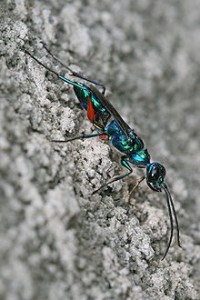The video below is about the Emerald Cockroach Wasp, also called the Jewel Wasp and Ampulex compressa. To say that this little bugger is vicious is a mild understatement.
Emerald Cockroach Wasp
[youtube http://www.youtube.com/watch?v=qN2XMyxAs5o?feature=player_detailpage&w=640&h=360]
From wikipedia: The emerald cockroach wasp or jewel wasp (Ampulex compressa) is a solitary wasp of the family Ampulicidae. It is known for its unusual reproductive behavior, which involves stinging a cockroach and using it as a host for its larvae. It thus belongs to the entomophagous parasites.
Distribution:
The wasp is mostly found in the tropical regions of South Asia, Africa and the Pacific islands. The flying wasps are more abundant in the warm seasons of the year.
A. compressa was introduced to Hawaii by F.X. Williams in 1941 as a method of biocontrol. This has been unsuccessful because of the territorial tendencies of the wasp, and the small scale on which they hunt.
Appearance:
The wasp has a metallic blue-green body, with the thighs of the second and third pair of legs red. The female is about 22 mm long; the male is smaller and lacks a stinger.
Reproductive Behavior and Life Cycle:
As early as the 1940s it was reported that female wasps of this species sting a roach (specifically a Periplaneta americana, Periplaneta australasiae or Nauphoeta rhombifolia) twice, delivering venom. A 2003 study using radioactive labeling demonstrated that the wasp stings precisely into specific ganglia of the roach. It delivers an initial sting to a thoracic ganglion and injects venom to mildly and reversibly paralyze the front legs of its victim. The biochemical basis of this transient paralysis is discussed in a 2006 paper. Temporary loss of mobility in the roach facilitates the second venomous sting at a precise spot in the victims’s head ganglia (brain), in the section that controls the escape reflex. As a result of this sting, the roach will first groom extensively, and then become sluggish and fail to show normal escape responses. In 2007 it was reported that the venom of the wasp blocks receptors for the neurotransmitter octopamine.
The wasp proceeds to chew off half of each of the roach’s antennae. Researchers believe that the wasp chews off the antenna to replenish fluids or possibly to regulate the amount of venom because too much could kill and too little would let the victim recover before the larva has grown. The wasp, which is too small to carry the roach, then leads the victim to the wasp’s burrow, by pulling one of the roach’s antennae in a manner similar to a leash. Once they reach the burrow, the wasp lays a white egg, about 2 mm long, on the roach’s abdomen. It then exits and proceeds to fill in the burrow entrance with pebbles, more to keep other predators out than to keep the roach in.
With its escape reflex disabled, the stung roach will simply rest in the burrow as the wasp’s egg hatches after about three days. The hatched larva lives and feeds for 4–5 days on the roach, then chews its way into its abdomen and proceeds to live as an endoparasitoid. Over a period of eight days, the wasp larva consumes the roach’s internal organs in an order which maximizes the likelihood that the roach will stay alive, at least until the larva enters the pupal stage and forms a cocoon inside the roach’s body. Eventually the fully grown wasp emerges from the roach’s body to begin its adult life. Development is faster in the warm season.
Adults live for several months. Mating takes about one minute, and only one mating is necessary for a female wasp to successfully parasitize several dozen roaches.
While a number of venomous animals paralyze prey as live food for their young, Ampulex compressa is different in that it initially leaves the roach mobile and modifies its behavior in a unique way. Several other species of the genus Ampulex show a similar behavior of preying on cockroaches. The wasp’s predation appears only to affect the cockroach’s escape responses. Research has shown that while a stung roach exhibits drastically reduced survival instincts (such as swimming, or avoiding pain) for approximately 72 hours, motor abilities like flight or flipping over are unimpaired.
Biomechanics:
The first sting is delivered to the prothoracic ganglion (mass of nerve tissue) which causes 2-3 minute paralysis of the front legs. This sting injects significant quantities of gamma amino-butyric acid (GABA) and complementary agonists taurine and beta-alanine. The concoction temporarily blocks the motor action potentials in the prothoracic ganglion by depressing cholinergic transmission through the increased chloride conductance across nerve synapses. Individually, all of these substances induce short-term paralysis of the cockroach. When they are injected together in a ratio of 1:0.7:0.4, the effect was longer lasting. GABA activates liquid-gated chloride channels by binding to GABA receptors. Taurine and beta-alanine likely extend the duration of the paralytic affect by slowing the uptake of GABA by the synaptic cleft. Combined, this cocktail of compounds prevents the cockroach from moving and defending itself while the wasp administers the second sting/series of stings.
The second sting turns the cockroach into a zombie of sorts, or a dog on a leash. This sting is administered to the sub-esophageal ganglion (SEG) and is much more precise, hence the need for paralysis and is significantly longer. Studies have shown the wasp actively searches for the SEG during this sting. The second sting inhibits the cockroach’s ability to walk spontaneously, or of its own will, however cockroaches CAN right themselves and swim while under the influence and when startled, will jump but not run. It also causes excessive grooming and alterations in the metabolism of the cockroach. Scientists suspect the metabolic change preserves nutrients for the wasp larva. Researchers have simulated this zombie state by injecting procaine into the SEG. They also determined using extracellular bipolar electrode that neuronal activity was less in stung cockroaches. Research suggests that the venom disturbs the octopaminergic modulation in structures within the roach’s ganglion. Basically, it limits the effectiveness of octopamine, the neurotransmitter that controls muscle contraction in sudden movements.














